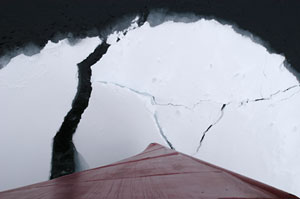 |
Daily Update
Calendar
Dispatch 07 - September 16, 2003
By C. A. Linder
Weather conditions: Overcast skies, 30 kt
winds, 1-2 ft seas, air temperature 29°F
Iceblink
Since we have been seeing a lot of ice in the past few days, I'll
open this dispatch with some great questions about ice from Mrs.
Cadwell's students at Varnum Brook Elementary School in
Pepperell, Massachusetts.
 |
 |
| What it feels like
to be an ice floe in Healy's way... The giant red hull
smashes this floe to bits. |
| Click
to enlarge |
Question: If the air temperature is 35°F, can the water be colder and not freeze?
If the temperature is below freezing, is the water temperature also below
freezing? If it is, how does the water life not become frozen, floating,
fish sticks?
Answer: Ice formation is very fascinating! We should
observe the onset of pack ice formation at the end of the cruise,
in late October. Seawater freezes at a temperature of -2°C (28.4°F).
This is lower than the freezing point of freshwater because of the
dissolved salts. If the air temperature is below freezing, the water
temperature may also be below freezing, but not necessarily.
Water has a high specific heat compared to air, meaning that it takes
a lot of cold air to cool seawater to the freezing point. Think about
your favorite swimming hole - it sometimes takes all summer to warm
it up enough so that you can swim in it. As far as fish sticks are
concerned, I decided to ask biological oceanographer Carin Ashjian
about what kinds of plants and animals live in and around this icy
environment.
"Puddles and freshwater ponds can freeze solid in the winter if the air is cold enough. Sea ice, on the other hand, never completely freezes all of the ocean beneath it. The animals and the plants that live in this cold water just beneath the ice are adapted to these temperatures - they are used to it. There are even some plants and animals that live in tiny spaces within the ice. In the springtime, there are plants that grow on the underside of ice - ice algae."
Molly from Mrs. Werner's class at the Morse
Pond School in Falmouth, Massachusetts also wanted to know...
Question: How thick is the ice this time of year?
Answer: Sea ice thickness varies throughout the Arctic.
In the center of the Arctic Ocean, the ice has survived many summers
without melting - this is called multiyear ice and can be up to 8
meters (25 feet - the size of a two storey house) thick. We are on
the very edge of the ice pack right now, breaking through melted chunks
of annual ice. This is the ice that forms each winter and melts each
summer. Typically this ice is only 2-3 meters (6-10 feet) thick. We
have also seen some broken pieces of multiyear ice that have been
about as big as a large truck.
Since we're on the topic of ice, one other thing we have observed
is a phenomenon known as "iceblink."
Sunlight reflecting off of ice creates a bright band on the undersides
of low clouds. Conversely, dark sky reflecting open water is known
as "water sky." Early arctic explorers used this atmospheric
effect to find leads, or areas of open water, through the ice.
Mrs. Cadwell's students also wanted to know about
what things whale biologist Lisa Munger has heard with her sonobuoys.
Question: What kinds of wildlife have you seen? What
has Lisa Munger heard so far?
Answer: Today we saw a mother
polar bear and cub, a flock of kittiwakes,
and a bearded seal. Lisa told me she has heard "waves sloshing,
ice crackling, and lots of pings from the ship--2 depth sounders and
sending the acoustic release commands to the moorings. I haven't heard
any animals yet--I think I might do some night listening too, as many
animals call more at night than during the day."
The science team finished another section of CTDs
today. We are measuring the temperature, salinity (saltiness), nutrient
and biological content of the water. Tomorrow we will attempt to recover
the second University of Washington mooring - we have our fingers
crossed that the releases will work this time so that we don't have
to waste precious time dragging for the instruments.
 Previous
Dispatch Next Dispatch Previous
Dispatch Next Dispatch

Back to
Calendar
|




